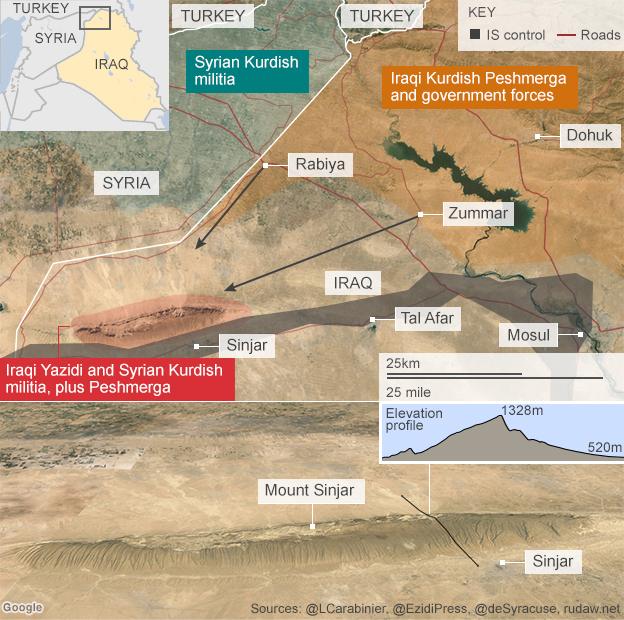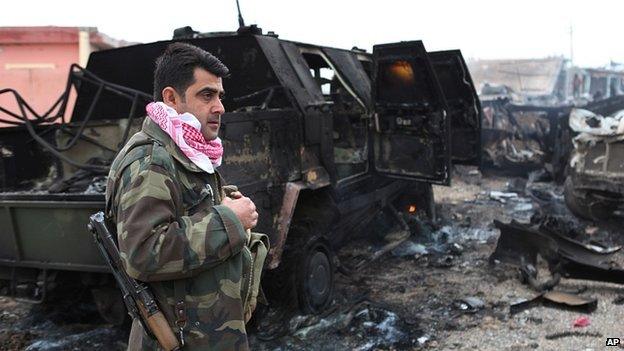Mount Sinjar: Islamic State siege broken, say Kurds
- Published
Jiyar Gol in Irbil says the news has brought hope and optimism to Yazidis
Kurdish forces in northern Iraq are claiming their biggest victory yet against Islamic State (IS) militants.
They say they have broken the IS siege of Mount Sinjar, where thousands of Yazidis and other displaced Iraqis have been trapped since August.
IS controls a swathe of Iraq and Syria, where it has declared a caliphate.
Meanwhile, the Pentagon's top officer says US air strikes have killed several high-ranking military leaders of IS in Iraq.
The Kurdish offensive against IS forces besieging Mount Sinjar began early on Wednesday with the most intensive round of air strikes yet by US and coalition forces - 45 in all.


Kurdish security forces have been trying to stem the IS advance across Iraq's northern Nineveh province
On the ground, about 8,000 Kurdish peshmerga fighters launched a two-pronged attack which they said had succeeded in opening a wide corridor to allow members of the Yazidi minority and others to leave.
Masrur Barzani, Chancellor of the Kurdistan Region Security Council, said the operation had been to advance from Zumar - which Kurdish forces recaptured in October - to Mount Sinjar and to rescue the Yazidi people trapped there.
"It was a very big operation and thankfully it was concluded very successfully," he said.

Watch as the BBC explains the significance of Mount Sinjar
Analysis: The BBC's Jim Muir in Beirut
By the Kurds' account, this was the biggest offensive ever mounted by anybody against IS, with 8,000 Kurdish peshmerga forces involved and an unprecedented aerial bombardment from the Americans to weaken the militants.
But its objective was limited to breaking the siege IS has imposed on Mount Sinjar since August. That, the Kurds say, was achieved in less than two days.
The Kurdish command knows that a lot remains to be done, and that the going will be tough. The ring of steel around the mountain may have been breached, but much of it is still there. Sinjar the town, further south, is on a vulnerable area of terrain along the Syrian border.
That will be the next target. But the militants remain entrenched in Mosul and Tal Afar to the east and Syria to the west, exposing the Kurds' flanks.
The Kurds regard Sinjar as part of Kurdistan. But not Mosul and other Arab or Sunni areas - they are an Iraqi problem, one the Kurds will not tackle on their own.

Peshmerga commanders said they expected the evacuation of those trapped on the mountain to begin on Friday.
A statement from the Kurdish command said large numbers of militant fighters had fled westwards into Syria or eastwards towards Mosul, which they captured in June.
The peshmerga also said eight villages had been recaptured and about 80 militants killed in the offensive.
IS captured the town of Sinjar in August forcing thousands of residents, mainly from the Yazidi sect, to flee. Many were airlifted off the nearby mountain but thousands more who came later found themselves trapped.
'High-value targets'
The attack on Sinjar was one of the reasons the US began air strikes against IS positions in Iraq in August. It expanded its air campaign into Syria the following month.

Who are the Yazidis?
Yazidis revere the Bible and Koran - but much of their tradition is oral
Religious sect found in northern Iraq, Syria and the Caucasus
Religion incorporates elements of many faiths, including Zoroastrianism
Principal divine figure, Malak Taus (Peacock Angel), is the supreme angel of the seven angels who ruled the universe after it was created by God
Many Muslims and other groups incorrectly view Yazidis as devil worshippers
There are estimated to be around 500,000 Yazidis worldwide, most living in Iraq's Nineveh plains
In August 2007 jihadists attacked Yazidi villages in Nineveh, killing between 400 and 700 people

Gen Martin Dempsey, chairman of the US Joint Chiefs of Staff, said the air strikes that had killed the IS leaders were designed to hamper the Islamist group's ability to conduct attacks, supply fighters and finance operations.
Gen Dempsey told the Wall Street Journal that the loss of IS leaders was "disruptive to their planning and command and control".
He added: "These are high-value targets, senior leadership."
Pentagon officials said that between 3 and 9 December, US air strikes killed Abd al-Basit, head of IS military operations in Iraq, and Haji Mutazz, a key aide of IS leader Abu Bakr al-Baghdadi.
They added that in late November another strike killed Radwin Talib, IS governor of the northern Iraqi city of Mosul.
Other defence officials said a number of senior and mid-level IS commanders had also died in air strikes, and that they believed this was beginning to significantly weaken the group's leadership structure.
